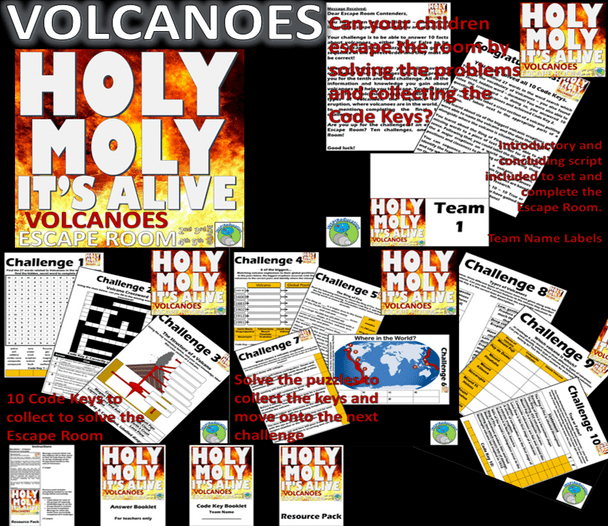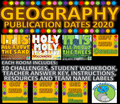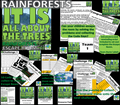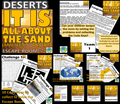Description
We have now completed putting together this growing bundle of Geography themed Escape Rooms within the following geographical study areas:
- Volcanoes
- Rainforests
- Deserts
- Oceans
- Continents
- Mountains
- World Rivers
- The Water Cycle
Therefore, there are now eight Escape Rooms completed
Using an Escape Room to develop curriculum knowledge is an exciting activity that will inspire learners from 2nd Grade to 7th Grade. The aims of these Escape Rooms is to provide jeopardy for the students to work under pressure to solve 10 clues in each room to help raise their knowledge of the theme being studied and investigated. The 10 Challenges within these Escape Room will support knowledge and understanding of the geographical features, positions, sizes and importance to living things of all areas of study from volcanoes to rainforests to oceans, mountains, continents, world rivers, the water cycle and deserts. The whole bundle will be a very valuable asset to any classroom and make the learning, both introduction to a new topic, or a review of a completed sequence, exciting, unusual and inclusive!
Each Escape Room includes:
- 9/10 Challenges for students to solve based on the theme before they can leave the Escape Room (all within a Code Key Booklet for the students to complete)
- Answer Key for the teachers
- Full instructions for setting up and running each Escape Room
- Opening script to set the scene for each Escape Room
- Closing celebratory script to be read when the students have successfully completed all 9/10 challenges
- Team name table labels for students to choose their own team names and label their table using the themed labels provided.
Examples of the standard of the challenges and our Escape Room quality can be seen in the preview of this product and the feedback given in our Science, History, Maths and Literacy based Escape Rooms.
The contents of each Escape Room is as follows for the current published rooms:
Volcanoes: Holy Moly - It's Alive!
The 10 activities are based on the following outcomes:
- Word Search to introduce 27 key words related Volcanoes ensuring that children develop a wide vocabulary. There is also an extra hidden word which the children must find in order to solve the Code Key and move to the next challenge.
- Crossword to complete which introduces further important information to the children – there are 10 clues to solve.
- Labelling a cross section of a volcano using 8 key features
- Date, name of volcano and global position of the 6 biggest eruptions in world history
- The Ring of Fire – add the missing words to make the text make sense
- Where in the World? Identifying the Ring of Fire and 6 main volcanoes on a map of the world
- Sequencing the events leading up to a volcanic eruption – what to look for and what will happen next
- Features of three different types of volcanoes
- Identifying global volcanoes in one of the three different types
- True or False – final challenge using the knowledge gained within this Escape Room – 10 statements.
Rainforests: It Is All About the Trees!
The 10 activities are based on the following outcomes:
- Word Search to introduce 31 key words related Rainforests ensuring that children develop a wide vocabulary. There is also an extra hidden word which the children must find in order to solve the Code Key and move to the next challenge.
- Crossword to complete which introduces further important information to the children – there are 14 clues to solve.
- Labelling a cross section of a rainforest with the different layers and the correct amount of sunshine each levels receive.
- Name of the rainforests across the planet and their global position
- Importance of rainforests – add the missing words to make the text make sense
- Where in the World? Identifying Rainforests on a map of the world
- How trees produce oxygen
- Difference between temperate and tropical rainforests
- True or False? Final challenge using the knowledge gained within this Escape Room – 10 statements.
Deserts: It Is All About the Sand - and Ice!
The 10 activities are based on the following outcomes:
- Word Search to introduce 25 key words related Deserts ensuring that children develop a wide vocabulary. There is also an extra hidden word which the children must find in order to solve the Code Key and move to the next challenge.
- Crossword to complete which introduces further important information to the children – there are 12 clues to solve.
- Labelling an image of a desert with 6 key features
- Linking the names and global position of 10 of the world’s biggest Deserts
- What is a desert? – add the missing words to make the text make sense
- Where in the World? Identifying key lines on world map (Tropics of Cancer, Capricorn and Equator) and 9 key deserts in the world on a world map
- Linking the size of deserts with their names
- Matching the features of four different types of deserts to the correct desert and introducing students to the notion that both the Arctic and Antarctic are deserts due to their lack of rainfall and access to water
- Identifying which desert falls into which of the four desert types
- True or False – final challenge using the knowledge gained within this Escape Room – 10 statements.
Oceans: It's all about the water!
The 10 activities are based on the following outcomes:
- Word Search to introduce 25 key words related Oceans ensuring that children develop a wide vocabulary. There is also an extra hidden word which the children must find in order to solve the Code Key and move to the next challenge.
- Crossword to complete which introduces further important information to the children – there are 15 clues to solve.
- Labelling a cross section of an ocean with 8 key features identified (surface, continental slope, rise and shelf, abyssal plain, oceanic trench, volcanic island and mid-ocean ridge)
- Linking the names and global position of the 5 oceans of the world
- Oceans – Cloze Procedure – add the missing words to make the text make sense – oceans, movement of water, structure and importance to life on Earth
- Where in the World? Identifying key lines on world map (Tropics of Cancer, Capricorn and Equator) and the positions of the 5 World Oceans
- Linking the size of oceans with their names and sequencing the oceans from largest to smallest
- Vocabulary of water bodies and their definitions (ocean, sea, river, lake, stream, pond, rockpool, swamp)
- Facts about oceans – guess the ocean from the fact given (position, size, features, comparison with other oceans)
- True or False – final challenge using the knowledge gained within this Escape Room – 10 statements.
Continents: It's all about the land mass!
The 9 activities are based on the following outcomes:
- Word Search to introduce 25 key words related to Continents ensuring that children develop a wide vocabulary. There is also an extra hidden word which the children must find in order to solve the Code Key and move to the next challenge.
- Crossword to complete which introduces further important information to the children – there are 15 clues to solve.
- Linking the names and global position of the 7 continents of the world
- Continents – Cloze Procedure – add the missing words to make the text make sense
- Where in the World? Identifying key lines on world map (Tropics of Cancer, Capricorn and Equator) and the positions of the 7 Continents
- Linking the size of continents with their names and sequencing the continents from largest to smallest – population and land mass
- Vocabulary of land masses (plate tectonic, continent, archipelago, basin, desert, fault, island, mountain)
- Facts about continents – guess the continent from the fact given (position, size, features, comparison with other continents)
- True or False – final challenge using the knowledge gained within this Escape Room – 10 statements.
Mountains: It's all about the peaks!
The 9 activities are based on the following outcomes:
- Word Search to introduce 25 key words related Mountains ensuring that children develop a wide vocabulary. There is also an extra hidden word which the children must find in order to solve the Code Key and move to the next challenge.
- Crossword to complete which introduces further important information to the children – there are 13 clues to solve.
- Linking the names and global position of the main mountain ranges of the world
- Mountains – Cloze Procedure – add the missing words to make the text make sense – mountains, creation, ranges and some facts involved with specific ranges
- Where in the World? Identifying key lines on world map (Tropics of Cancer, Capricorn and Equator) and the positions of key mountain ranges in the world
- Vocabulary of mountains and their definitions
- Facts about mountain ranges – guess the mountain range from the fact given (position, size, features, comparison with other ranges)
- True or False – final challenge using the knowledge gained within this Escape Room – 10 statements.
Rivers: It's all about the water!
The 10 activities are based on the following outcomes:
- Word Search to introduce 25 key words related Rivers ensuring that children develop a wide vocabulary. There is also an extra hidden word which the children must find in order to solve the Code Key and move to the next challenge.
- Crossword to complete which introduces further important information to the children – there are 15 clues to solve.
- Labelling a cross section of a river with 9 key features identified (source, mouth, ocean/sea, estuary, delta, ox bow lakes, flood plain, tributary, meander)
- Linking the names and global continent position of 15 rivers in the world
- Rivers – Cloze Procedure – add the missing words to make the text make sense – journey of a river from source to mouth using the key vocabulary
- Where in the World? Identifying the position of 16 major rivers in the world
- Linking the size of rivers to their lengths
- Vocabulary of water bodies and their definitions (ocean, sea, river, lake, stream, pond, rockpool, swamp)
- Facts about rivers – guess the river from the fact given (position, size, mouth position, comparison with other oceans)
- True or False – final challenge using the knowledge gained within this Escape Room – 10 statements.
Its all about the Cycle - The Water Cycle
The 10 activities are based on the following outcomes:
- Word Search to introduce 25 key words related to the Water Cycle ensuring that children develop a wide vocabulary. There is also an extra hidden word which the children must find in order to solve the Code Key and move to the next challenge.
- Crossword to complete which introduces further important information to the children – there are 13 clues to solve.
- Linking scientific vocabulary to their definitions – 5 words integral to the Water Cycle
- Labelling a scientific diagram of a cross section of the Earth – adding on 6 key terms within the water cycle – in action in the diagram.
- Linking the names and global continent position of 12 deserts in the world, and explaining how their position in the world impacts on their geographical features.
- The Water Cycle – Cloze Procedure – add the missing words to make the text make sense – the processes in the Water Cycle
- Where in the World? Identifying the position of 12 major deserts in the world and explaining how their position influences their conditions (equatorial links)
- What will happen next – predicting the processes which will occur in real-life scenarios and why.
- Vocabulary of water bodies and their definitions (ocean, sea, river, lake, stream, pond, rockpool, swamp)
- Real life processes – given 14 scenarios, students to select the processes involved within the water cycle from evaporation, condensation, transpiration, infiltration or precipitation – or a mixture of more than one!
- True or False – final challenge using the knowledge gained within this Escape Room – 10 statements.
Setting up the Escape Room
1. Children should be split into groups of no more than four and be placed in their own workspace.
2. Access to IT and research materials should be provided to allow children to research answers to questions and review their own knowledge, as well as checking answers.
3. Each group should have a Code Key Booklet and decide on a team name
4. Read the Initial Message to the children to set the challenge in context. Discuss what this means, and what the activity entails.
5. Turn to Code Key 1. Agree with the children a set time to complete the problem in – this ensures that the children stay on task and maintains the Escape Room element of working under pressure.
6. At the end of the time, children should have filled in the Code Key in their booklet. The teacher can then check the accuracy of all the groups and talk through the responses the children should have.
7. Move on through the remaining challenges until all 10 have been completed.
8. For those groups who have been successful, they are then able to read the completed statement where they find out if they have escaped the Escape Room!
There are other ways of running Escape Room activities, for example, each activity could be set up on 10 tables and the children then move from table to table completing the activity. This would reduce the need for as many resources, and access to non-fiction sources and Internet Resources could then be targeted at specific Challenges.
Each Escape Room should last for at least 2 hours.
We hope that your children enjoy these Escape Rooms.
Thank you for visiting our store.
Best wishes
INSPIReducation



















